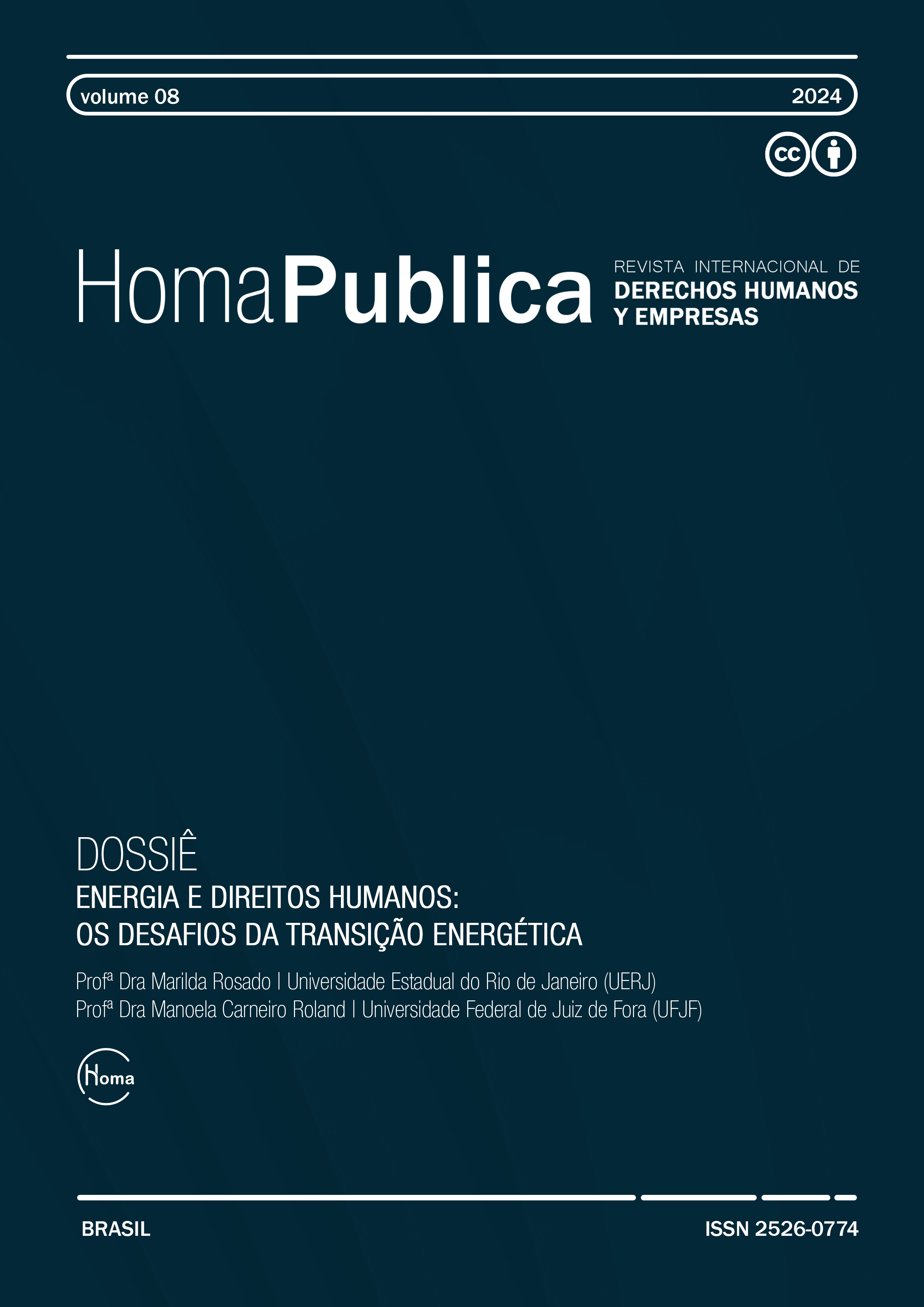The oil industry in a burning world: how can unitilization shape the oil industry to mitigate climate change?
Publicado 2024-09-17
Palabras clave
- Unitization,
- International Law,
- Climate Change,
- Gas and Oil
Cómo citar
Derechos de autor 2024 Homa Publica - Revista Internacional de Derechos Humanos y Empresas

Esta obra está bajo una licencia internacional Creative Commons Atribución 4.0.
Resumen
Countries and companies likewise ought to take ever more bolder actions due to the aggravation of climate change impacts. Taking this into consideration, the international community and its actors have been seeking commitments to renew climate actions and fulfill the transition to a sustainable society. The need to take actions to mitigate and to adapt to climate change impacts, and hence promoting justice, encompasses all human activities. As such, energy production takes a special place in the green transition. It massively contributes to human-driven climate change through high GHG emissions. Nevertheless, it still lacks international binding rules, comprehensive governance and innovative policies. Indeed, before full-fledge transition, international climate bodies recognize the urgency of short-term solutions. Thus, practices that enhance energy efficiency become much needed climate actions. Unititzation presents itself as a widespread practice in national jurisdictions. However, it is not properly implemented in many countries and does not encompass international oil fields. Considering the commitments undertaken, the costumes and rules in regard to climate, one must reach the conclusion that unitization has become mandatory practice in oil extraction, production and transportation in order to reduce waste and improve energy efficiency. States’ duties do not end in cooperation, common procedures and rules must accompany the development of joint oil and gas reserves.
Descargas
Citas
- Abbott, K. (2014). Strengthening the Transnational Regime Complex for Climate Change.
- Transnational Environmental Law, 3 (1), p. 57-88.
- Asmus, D. & Weaver, J. (2006). Unitizing Oil and Gas Fields Around the World: A Comparative
- Analysis of National Laws and Private Contracts. Houston Journal of International Law, 28 (3).
- Benvenisti, E. (2002). Sharing Transboundary Resources: International Law and Optimal
- Resource Use. Cambridge: Cambridge University Press.
- Bodansky, D. (1999). The Legitimacy of International Governance: A Coming Challenge for
- International Environmental Law. American Journal of International Law, 93 (3), p. 596–624.
- Braga, L. P. et al. (2023). How transnational rules can contribute to the improvement of the
- Brazilian regulatory system for unitization—an analysis under the transnational legal order perspective. The Journal of World Energy Law & Business, 16 (4) p. 367–384.
- Burgers, L. (2022). Private Rights of Nature. Transnational Environmental Law, 11 (3), p. 463- 474.
- Chayes, A. & Chayes, A. H. (1995). The New Sovereignty: Compliance with International
- Regulatory Agreements. Cambridge: Harvard University Press.
- Dernbach, J. C. (2016). Chapter I.40: Energy efficiency and conservation in Elgar
- Encyclopedia of Environmental Law. Cheltenham: Edward Elgar Publishing
- Dolzer, R. (2015). International Co-operation in Energy Affairs in: Collected Courses of the
- Hague Academy of International Law, Tome/Volume 372. Leiden: Brill.
- De Graaf, K. J., & Squintani, L. (2021). Chapter IX.4: Sustainable development, principles of
- environmental law and the energy sector in Elgar Encyclopedia of Environmental Law. Cheltenham: Edward Elgar Publishing.
- Halliday, T. C. & Shaffer, G. (2005). Transnational Legal Orders. Cambridge: Cambridge
- University Press.
- Heffron, R. (2022). Applying energy justice into the energy transition. Renewable and
- Sustainable Energy Reviews, 156.
- IPCC. (2023). Climate Change 2023: Synthesis Report. Geneva.
- Jefferson, D., Mapherson, E. & Moe, S. (2023). Experiments with the Extension of Legal
- Personality to Ecosystems and Beyond-Human Organisms: Challenges and Opportunities for Company Law. Transnational Environmental Law, 12 (2), p. 343-365.
- Kurki, V. (2022). Can Nature Hold Rights? It's Not as Easy as You Think. Transnational
- Environmental Law, 11 (3), p. 525-552.
- Pierce, D. E. (2009) Minimizing the Environmental Impact of Oil and Gas Development by
- Maximizing Production Conservation. North Dakota Law Review, 85 (4), p. 759- 774.
- Roggenkamp, M. M. (2021). Chapter IX.2: Regulating the energy chain in Elgar Encyclopedia
- of Environmental Law. Cheltenham: Edward Elgar Publishing.
- Stranadko, N. (2022). Global climate governance: rising trend of translateral
- cooperation. Int Environ Agreements, 22, p. 639–657.
- United Nations. (1999). Second stage of the proceedings between Eritrea and Yemen
- (Maritime Delimitation). Reports of International Arbitral Awards, XXII, p.335-410.
- Worthington, P. F. (2020). The Law on Petroleum Unitization. Cheltenham: Edward Elgar
- Publishing.

